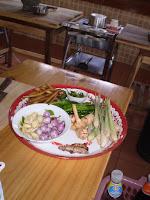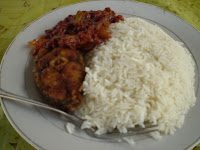If
you spend the majority of your time in Anglo Saxon country you will know that
the food is a tad bland and devoid of any real flavour and so one of the best
things about travelling is trying many new, exciting and wonderfully tasting
dishes.
One
of the stand out trips for me, food wise, was Thailand. Volunteering in a hill
tribe meant that food was super authentic and very different.
 We
ate stir-fry pretty much all the time which was prepared in this hut and brought
out on this small round table we ate outside with chickens and dogs running
around our ankles. Likely, I love food and have a fairly robust stomach so I
wasn’t bothered by this in the slightest.
We
ate stir-fry pretty much all the time which was prepared in this hut and brought
out on this small round table we ate outside with chickens and dogs running
around our ankles. Likely, I love food and have a fairly robust stomach so I
wasn’t bothered by this in the slightest.  My
most memorable dish was Chang Mai Noodles and this is a bit like the Malaysian
Laksa but hotter and with crispy noodles. The first time we had this dish was
on a local road side joint on the way to Chang Rai and I thought the amount of
chilli would propel us in to space but seriously, it was divine. The second
time around was a lot more bearable chilli-wise but no less wonderful.
My
most memorable dish was Chang Mai Noodles and this is a bit like the Malaysian
Laksa but hotter and with crispy noodles. The first time we had this dish was
on a local road side joint on the way to Chang Rai and I thought the amount of
chilli would propel us in to space but seriously, it was divine. The second
time around was a lot more bearable chilli-wise but no less wonderful. Another
great memory from this trip was doing a cooking class. I totally recommend this
for anyone who likes food and travels a bit as you get more of a feel of the
local cuisine and hopefully a few tips on how to cook some dishes at home. Some
classes even take you to the markets to pick up some supplies and this can be
great as markets are always entertaining and full of the unexpected.
Another
great memory from this trip was doing a cooking class. I totally recommend this
for anyone who likes food and travels a bit as you get more of a feel of the
local cuisine and hopefully a few tips on how to cook some dishes at home. Some
classes even take you to the markets to pick up some supplies and this can be
great as markets are always entertaining and full of the unexpected.
Spending
3 interning months in Malaysia was incredible in so many ways but one of best
thing about it was, because of the cost, eating out every day of the week.
If
any of you know some Malaysians you will know that one of the first questions
that they will ask you after saying hello is ‘have you eaten yet?’ I know the
enjoyment of food is pretty universal but the Malaysians take food obsession to
a whole new level. It soon became very normal to start planning what you eat
for breakfast, lunch and dinner from the moment you woke up.
With
Malaysia being home to 3 major ethnic groups, means that the kinds of dishes on
offer is very diverse. You can have curries one night, noodles the next and
Satay or Laksa the next with a Subway (I just had to get some fresh veggies in
at some point) for lunch. Nasi Lemak was always a favourite for breakfast.
 Trying
food from street stalls was another great memory. At first I was a little
nervous as I thought I would be getting gastro from eating the food but then I
realised that I should stop being a princess that has given way to 'Namby Pambiness' and that I had nothing to worry about.
Trying
food from street stalls was another great memory. At first I was a little
nervous as I thought I would be getting gastro from eating the food but then I
realised that I should stop being a princess that has given way to 'Namby Pambiness' and that I had nothing to worry about.
Long
after I have returned from Malaysia and Thailand, I’ve always gravitated
towards their cuisine and really attempt to recreate some of the dishes at home
but, in reality, they are a poor imitation.
You
wouldn’t necessarily go to Ghana for the food but spending 5 weeks there meant
that I got to taste a far bit of local food.
Ghana
being on the coast and an exporter of seafood, fish was a major part of any
meal as too was rice which often constituted a third of what was on the plate.
 |
| Haggis |
Food
in Edinburgh doesn’t always come to mind but I really enjoyed it. The carbs and
processed meat (i.e. sausages and Haggis) was always welcome after a long day
running around sightseeing this wonderful part of the world.
 |
| tasted nicer than it looked |
Chinese food was a delight, with its noodles and dumplings that has me going back for more than what was good for me. I loved every meal and every dish was amazing. Using chopsticks was a great noverlty as well as ordering multiple dishes and sharing them among you and your friends because, after all, eating is a communal activity.
I wouldn't say the Indian that I eat was a disappointment but it was just different to what I had grown up eating. Because I was in the south, it was vegetarian and a lot of rice. Not that I dislike rice but the amount did seem to be a fast track to type II diabetes. But there were several dishes that we did eat that were amazing and to die for but they were often at our local restaurant (don't think it catered for westerners) rather than at our homestay.
I love food!!! Food is great and obviously each place that you travel to offers something new, different and totally exciting. That's what makes travelling so cool.
 |
| Nicer than it looks, trust me!! |
I love food!!! Food is great and obviously each place that you travel to offers something new, different and totally exciting. That's what makes travelling so cool.





























